
(Download a higher resolution picture by clicking on any
picture below.) 
On June 24 and June 25, I was treated to a tour of China Lake Naval Air Weapons Station by Captain Jim Seaman, the Military Deputy Commander for Pacific Ranges. China Lake hosts some of the facilities of the Naval Air Warfare Center Weapons Division.
We visited the Explosive Ordnance Disposal (EOD) facility for an explosives demonstration. EOD handles the destruction of unexploded ordnance from the test ranges as well as out of date munitions and rocket engines.
Panorama of the main base area of China Lake NAWS. The town of Ridgecrest is at far left. The southern Sierra Nevada is on the horizon at center. The object at far right is a radar reflector mounted on a pole a few feet away. The explosive demonstration was set up in a small canyon just out of view on the right.
We drove up into a canyon where they explode small devices, less than 300 pounds of explosives. The EOD team had set up a series of demonstrations.
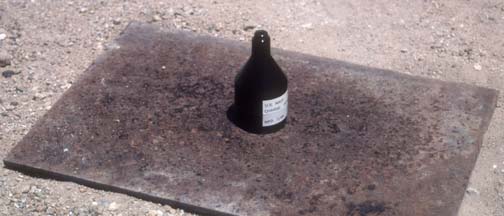 a
commercially available conical shape charge on a steel plate
a
commercially available conical shape charge on a steel plate
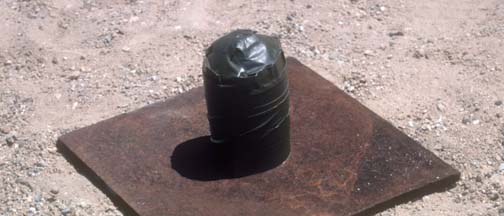 a
shape charge made from a wine bottle (the concave bottom works
nicely to focus the blast) on another steel plate
a
shape charge made from a wine bottle (the concave bottom works
nicely to focus the blast) on another steel plate
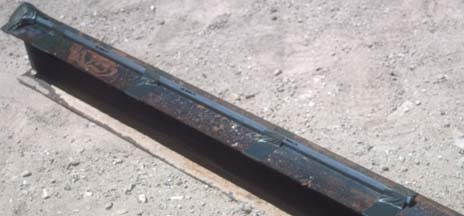 a linear
shape charge set to cut the flange off of an I-beam
a linear
shape charge set to cut the flange off of an I-beam
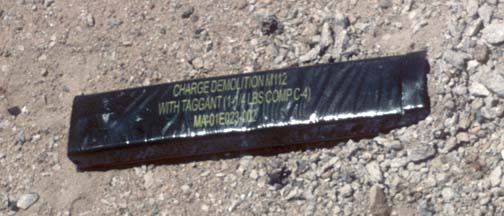 a
1.25-pound block of C4 explosive
a
1.25-pound block of C4 explosive
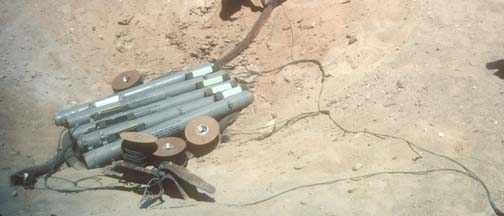 five outdated air-to-ground rocket motors with flexible shape
sharges wrapped around them
five outdated air-to-ground rocket motors with flexible shape
sharges wrapped around them
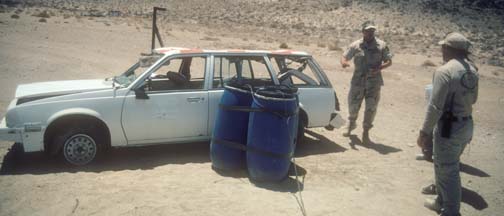 Three 45-gallon drums of water with C-4 explosive inside, placed
next to a car as an anti-car-bomb demo. The blast of water is intended to
disassemble the car-bomb components. The water spray loses much of
its force in a relatively short distance, limiting damage to the
surroundings.
Three 45-gallon drums of water with C-4 explosive inside, placed
next to a car as an anti-car-bomb demo. The blast of water is intended to
disassemble the car-bomb components. The water spray loses much of
its force in a relatively short distance, limiting damage to the
surroundings.
We took shelter in a bunker with a multiple mirror system for indirectly viewing the explosions. The EOD team pulled the time-delayed fuses on the charges and joined us. The charges went off at ten-second intervals, from smallest to largest. The bigger explosions lifted a cloud of dust off the ground and rattled the bunker.
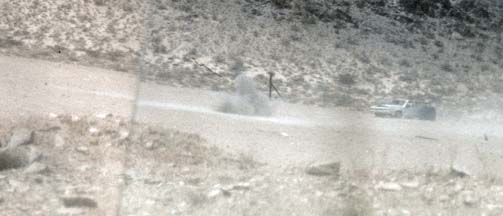 The commercially available conical
shape charge made a relatively small explosion. Most of the force
of the blast was directed downward.
The commercially available conical
shape charge made a relatively small explosion. Most of the force
of the blast was directed downward.
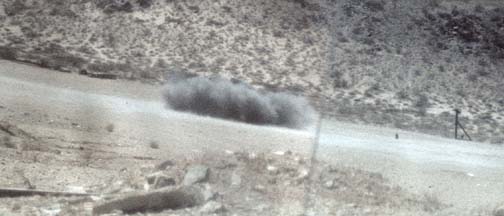 The shape charge made from a wine bottle was
quite a bit bigger. The can with the blasing cap was still
standing after the cap had been detonated.
The shape charge made from a wine bottle was
quite a bit bigger. The can with the blasing cap was still
standing after the cap had been detonated.
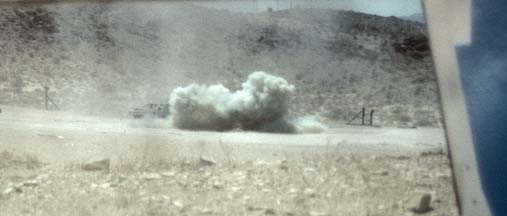 1-1/4 pound block of C-4. The edge of the
overhead mirror can be seen at right.
1-1/4 pound block of C-4. The edge of the
overhead mirror can be seen at right.
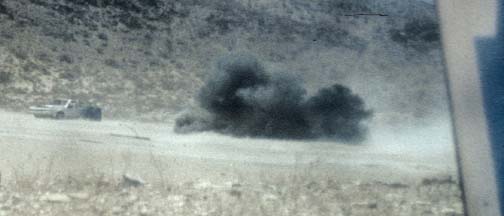 Rocket motor demolition detonation. The I-beam can be seen,
between the explosion and the car, with its flange peeled away by
the linear shape charge.
Rocket motor demolition detonation. The I-beam can be seen,
between the explosion and the car, with its flange peeled away by
the linear shape charge.
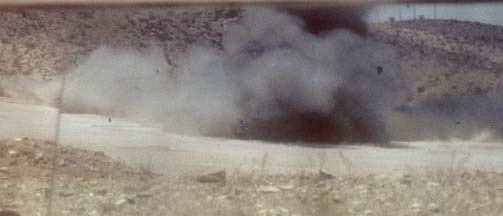 The
barrels of water blew the car into bits, hurling the rear end of
the car a hundred feet, and other small pieces much farther than
that.
The
barrels of water blew the car into bits, hurling the rear end of
the car a hundred feet, and other small pieces much farther than
that.
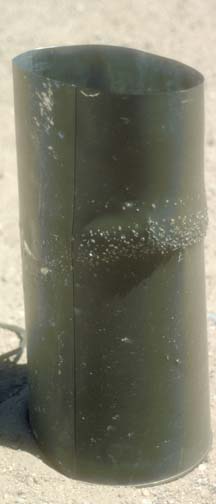 The blast pattern of the blasting cap is mostly directly out from
the sides with relatively little of the force directed out the
ends.
The blast pattern of the blasting cap is mostly directly out from
the sides with relatively little of the force directed out the
ends.
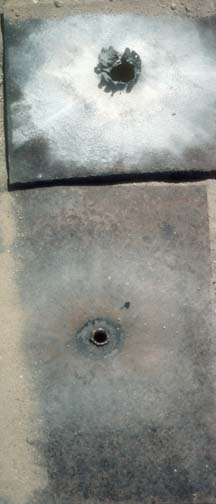 Holes were punched right through the steel plates that were under
the shape charges. The lower plate was penetrated by the
commercially manufactured shape charge. The upper plate was
penetrated by the shape charge that was made from a wine bottle.
It has been flipped over.
Holes were punched right through the steel plates that were under
the shape charges. The lower plate was penetrated by the
commercially manufactured shape charge. The upper plate was
penetrated by the shape charge that was made from a wine bottle.
It has been flipped over.
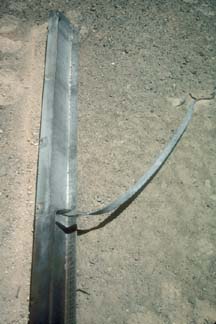 The I-beam flange was peeled away
by linear shape charge. Pitting can be seen on the lower flange
from the jet of plasma that cut through the upper flange.
The I-beam flange was peeled away
by linear shape charge. Pitting can be seen on the lower flange
from the jet of plasma that cut through the upper flange.
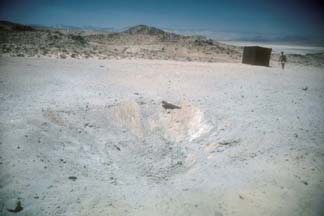 There was nothing left in the rocket motor demolition pit. Small
chunks of rocket fuel continued to smoke for several seconds.
There was nothing left in the rocket motor demolition pit. Small
chunks of rocket fuel continued to smoke for several seconds.
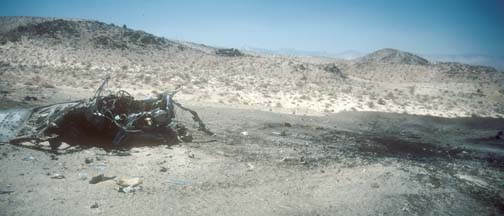 The "car bomb" was blown in two. The front half landed
several yards from where the car had been parked.
The "car bomb" was blown in two. The front half landed
several yards from where the car had been parked.
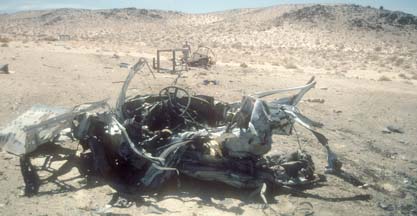 A member of the EOD team posed next to the rear half of the car
in the distance.
A member of the EOD team posed next to the rear half of the car
in the distance.
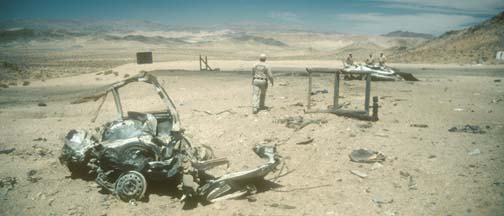 Looking from the rear half of the car to the front half.
Looking from the rear half of the car to the front half.
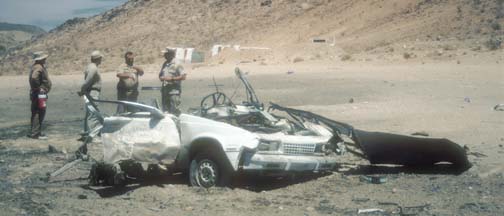 Captain Jim Seaman and the EOD team. The bunkers can be seen in
the background. We took shelter in a bunker hidden behind the
earthen embankment. The top mirror of the viewing system is just
visible in the background directly above the left headlight of
the car.
Captain Jim Seaman and the EOD team. The bunkers can be seen in
the background. We took shelter in a bunker hidden behind the
earthen embankment. The top mirror of the viewing system is just
visible in the background directly above the left headlight of
the car.
 Go to the main China Lake NAWS tour page.
Go to the main China Lake NAWS tour page.
Go to home page of the Goleta Air and Space Museum.
Send a message to Brian.